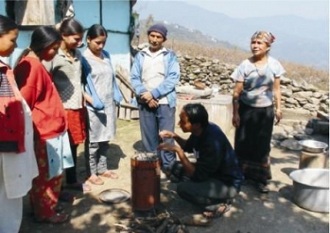WORLD LP GAS ASSOCIATION LAUNCHES GLOBAL CAMPAIGN TO REDUCE EXPOSURE TO INDOOR AIR POLLUTION CAUSED BY TRADITIONAL COOKING FUELS
COOKING FOR LIFE to expand access to safe cooking fuel to millions impacted by indoor air pollution
Bali, Indonesia — The World LP Gas Association (WLPGA) today announced a five-year campaign to bring LP Gas, a clean, safe and efficient cooking fuel to developing countries where people are affected by indoor air pollution.

The campaign, kicked off at the World LP Gas Forum in Bali, brings together industry leaders, governments and NGOs to raise awareness and access to this advanced alternative to harmful and deadly traditional cooking fuels like wood and charcoal.
“We are thrilled to launch this important campaign. Indoor air pollution is a devastating problem yet completely preventable. LP Gas can save lives, help the environment and make sure millions breathe easy for the first time,” WLPGA president James Rockall said. “Cooking – a tradition meant to nurture and sustain – should not kill.”
Two million people die each year from illnesses brought on by indoor air pollution in developing countries. Indoor air pollution causes respiratory infections, pulmonary disease, lung cancer, malnutrition, low birth weight, and other conditions. It is the tenth leading cause of avoidable deaths worldwide and in environmental causes of death is second only to contaminated waterborne diseases.
As the authoritative voice for the global LP Gas industry, WLGPA created COOKING FOR LIFE to use its broad membership and influence to tackle this widespread problem that U.S. Environmental Protection Agency Administrator Lisa Jackson calls “the ultimate environmental justice issue.”
LP Gas comprises butane or propane and is generated as a co-product of natural gas and crude oil production. It requires no additional effort to produce and burns clean with lower greenhouse emissions than any other fossil fuel. It is transportable, storable and non-toxic.
COOKING FOR LIFE urges leaders in government, NGO and private sectors to create and implement programs to bring LP Gas to the people impacted by indoor air pollution.
Countries including Indonesia, Brazil, and India have proven that large-scale adoption of LP Gas in both rural and urban households is possible.
Goals for the campaign include demonstrating the benefits of LP Gas to policymakers, educating women about the convenience of using LP Gas as a cooking fuel and promoting the expansion of demand and usage in the developing world.
WLPGA is a member of the Global Alliance for Clean Cookstoves, a public-private initiative led by the United Nations Foundation to raise awareness of options for clean cooking.
About The World LP Gas Association:
Established in 1987, the World LP Gas Association (WLPGA) is the authoritative voice of the LP Gas industry. WLPGA promotes the use of LP Gas worldwide to foster a cleaner, healthier, and more prosperous world. Its mission is to inform and educate all stakeholders on the benefits of LP Gas, support the development of LP Gas markets, promote compliance with standards, good business and safety practices, and identify innovation in the industry. WLPGA currently has the Special Consultative Status with the United Nations Economic and Social Council. www.worldlpgas.com/cooking-for-life
MEDIA CONTACT:
Giovanna Frank-Vitale
212-897-2076
gvitale@fenton.com




